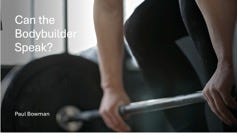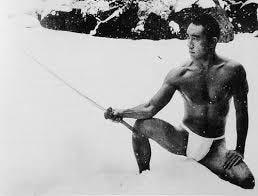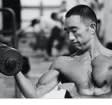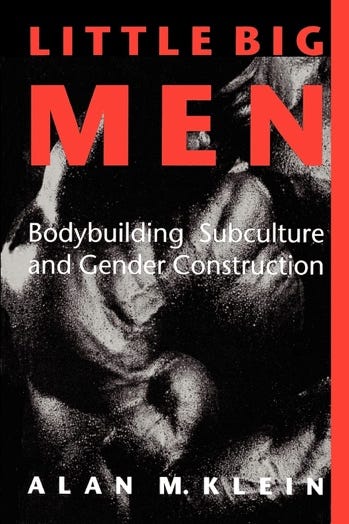Can the Bodybuilder Speak (full text)
Can the Bodybuilder Speak?
Research Seminar, School of Journalism, Media and Culture, Cardiff University, 12 Nov 2025
Paul Bowman
Cardiff University
1. The Dumb Body
In 2004, in the TV comedy show Malcolm in the Middle, Hal (played by Bryan Cranston) becomes entangled with a group of bodybuilders. These bodybuilders all seem to live in their speedo-sized posing pouches and – crucially – they are all absolutely and irretrievably stupid.
Also in 2004, the film Dodgeball appeared.[1]
A film about different kinds of gym cultures, in Dodgeball, the obsessive bodybuilders are not only stupid: they are also hypertrophically vain, judgemental, and screwed up. The corporate Globo-Gym is transparently neoliberalist – explicitly saying: compete against others and compete against yourself. Publicly affirm you are superior (privately hate yourself).
There is a lot to say about these comic stereotypes. But my starting point is merely this: despite its mainstreaming since the 1970s, the stereotype of the dumb bodybuilder remains.
Although it mainly emerged through the 1980s and 1990s, the stereotype also feels timeless. This is because it aligns perfectly with the most entrenched binary of the Western philosophical tradition: too much body equals not enough brain.
This inverse relationship can be traced to the melding of Christian and Platonic thought, which displaced an earlier Greek equation in which athletic body equalled the pinnacle of human possibility.
Platonic Christianity replaced this with the idea of the body as not only corruptible but actually corrupting. In (Augustinian) Christianity, our true quintessence is quite other than dumb flesh: it is the transcendent soul, which is often conflated with ‘mind’, and which itself is often conceptualised as quite other than body.
The concept of sin didn’t help the body either. And neither did the influence of René Descartes. For him, mind or logos defines the human.[2] Body and senses are not to be trusted at all.
2. Mind and Body
The bodybuilders in Malcolm in the Middle are dumb. The bodybuilders in Dodgeball are idiots. And what are our images of the bodybuilder in the gym?
These may move from taciturn to monosyllabic, to very shouty; either concentrating, focused, or wailing in pain, or aggression – howling like beasts.
The bodybuilder on stage is mute, emulating a statue; or, rather, a photograph – the photograph that they want to become.
Photography is the technology whose historical emergence defined the origin of bodybuilding as we know it. Bodybuilding was arguably invented by, through and for photography.
In general, there is not a lot of speaking directly associated with the bodybuilder. And when they do speak, it rarely helps.
When, in the 1977 feature, Pumping Iron, Arnold Schwarzennegger describes ‘the pump’ as orgasmic – this probably remains the most famous attempt to explain in words the appeal of bodybuilding training. Yet, Arnie later admitted that he mainly said all that in order to add drama and appeal to the documentary he was starring in. Outside of such utterances, the appeal of bodybuilding as practice remains, shall we say, ‘under-communicated’.
The Hollywood action film format hasn’t helped the status of bodybuilding either. While normalising hypertrophy, Hollywood demands hyperreal bodies for hyperreal roles. In this dynamic, actors aren’t simply typecast, they are type-made – literally made to order.
In probing ‘reasons’, the discourse around bodybuilding often forces it into one or another kind of stereotype: what drives the bodybuilder is either something competitive (Dodgeball’s Globo-Gym) or something pathological (Malcolm in the Middle’s ‘huger and shinier’).
Of these two, the pumped-up performative claim of ‘I train to compete’ feels most fragile. Indeed, to me, the idea that competitive ‘motivations’ are ‘primary’ smacks of ex post facto rationalisation. I do not believe that people get into bodybuilding because they want to compete. I believe that such a desire comes later, if at all.
Meanwhile, the discourse of mute, inexpressible obsession seems more honest. But it also reaches linguistic failure very quickly.
When bodybuilding ‘scientist’[3] Mike Israetel interviewed multiple title winning bodybuilder Natalie Hays, she turned the competitive rationale upside down by confessing not only that after every competition she felt thoroughly depressed, but also that she actually viewed competitions as huge annoyances – irritations that merely get in the way of what she really wants to be doing – which is nothing more nor less than simple, open-ended, ongoing, ‘intransitive’[4] training.
Hays’ position is brutally, beautifully honest. She doesn’t know why she trains, but she just has to train. All the competition stuff is just a kind of supplementary add-on.
The problem here is that this kind of discourse dwells around what Richard Rorty would call a ‘final vocabulary’ – the place at which language runs out, can’t communicate any further. A kind of internal limit or end of language.
This leads to the interpretive problem that, if people can’t articulate why they train, but train because they say they feel they have to train – either for pathological reasons or to keep themselves fungible, say, as actors or competitors – then bodybuilding will inevitably retain the cultural/theoretical status of symptom. The bodybuilder is either locked in a repetition compulsion or is an ideological dupe. Or both. Probably both, right?
3. Mute Speech
Against this backdrop – and faced with the enigma of the ‘mute speech’ of outsized lumps of meat who obsessively make themselves bigger for unclear reasons by moving metal up and down both animalistically and quasi-mechanically – cultural theorists and social critics have often been quick to provide interpretations.
The bodybuilder has been theorised as insecure, as narcissist, as a hypertrophic exemplification of ‘mass’ culture, as the spectacular subject of the society of the spectacle, the ultimate neoliberal individualist, even as a fascist.
However, to what extent are such interpretations adequate? Have they been projected onto ‘mute’ bodies illegitimately? (This is my first question.) Why is it that even bodybuilders themselves don’t seem able to articulate ‘that certain je ne sais quoi’ that pulls them back to the church, temple, factory or foundry of the gym? (This is my second question.)
Certainly, there are academic ethnographic studies and literary auto-introspections that have cast light on a range of subtle and complex motives, drives, satisfactions and gratifications, and I am very interested in these.
And the mainstreaming of the discourses of wellbeing, self-care and mindfulness have undoubtedly helped to provide culturally-intelligible – or at least culturally-sanctioned – terms of reference. However, it still largely remains the case that the practices, their points, pleasures, purposes and indeed outcomes are under-articulated, under-formulated – both by practitioners and by many cultural critics.
Furthermore, when it comes to the academic engagement with exercise, I am finding that even when scholarly treatments involve subtle, nuanced and engaged readings of the terrain, they still often cleave to one or another overarching – enabling but reciprocally limiting – cultural theory. Often, then, the exercise practice becomes translated, in the study, into signs, symbols or symptoms of larger problems. (Rarely solutions.)
Hence my title: ‘Can the Bodybuilder Speak?’ It echoes Gayatri Spivak’s argument that the subaltern is principally ‘spoken by’ other voices, rather than being able to speak or be ‘heard’ correctly. Spivak’s argument itself echoes Derrida’s prior claim that ‘being heard’ is what he called ‘structurally phenomenal’ and has ‘nothing to do with’ real sound, or actual embodied speech.
But what does the built body or the building of the body ‘say’? Is it even right to interpret bodybuilding as ‘saying’ anything at all? Or is it a mute speech, forever foreign to the world of words?
4. Presents
These are some of my questions. At present, I am researching pretty much anything and everything about the attempt to ‘explain’ bodybuilding phenomenology in words. Crucially, I am not really interested in the visible tip of the iceberg of bodybuilding – competitive bodybuilding. I am much more concerned with the often barely visible or non-spectacular realm – the bodybuilding that people rarely even recognise as bodybuilding.
But, to be clear: anyone who exercises to increase muscle size or to change their body shape is properly to be regarded as a bodybuilder. Competitive bodybuilders take muscular hypertrophy and reduction of bodyfat to the extreme; and they display that extreme condition only for the briefest moments. But most gym-goers aspire to a less dramatic, much more general, much longer-term increase in muscle size or strength, often alongside a reduction in bodyfat. These people are also bodybuilders. In fact, you are a bodybuilder not just if you want to wear bigger clothes, but even if you are merely trying to make your current clothes hang differently on your body.
(Like me, I suppose. I love the lifting, but I would never change my eating habits enough either to grow much or to lose much fact, and certainly not to achieve both at the same time!)
My specific interests lie in the phenomenology, affects and lived experiences of resistance training – the transformed knowledge of a terrain, the different embodied sense of self. And, of course, the relationship of such private or personal experiences with wider social and cultural phenomena, forces and (yes, inevitably) meanings – the relationship between the unspoken or perhaps unspeakable ‘presents’ of training and the world of words.
I use the word ‘presents’ the way Jacques Derrida once used it: to invoke both a moment, or unquantifiable ir/reality of uncountable moments – the momentary passing and changing of moments – and gifts. A present is also a gift that is given. Both a ‘now’ that has been given to us, and the thing that is given.
Much if this will inevitably feel incommunicable. As Michael Polanyi once put it, we know much more than we can say. This is another dimension of my question, ‘can the bodybuilder speak’. Can we articulate what we ‘get’ from exercise? Are those words adequate?
Japanese literary giant Yukio Mishima once theorised that the ‘world of muscle’ is actually alien to the ‘world of words’. (I have blogged and Substacked about this recently.) Yet, for any ideology theorist, exercise would have to be considered a most intimate interface of subject and structure.
At the same time, for any theorist interested in agency, too, this would also be ground zero.
In fact, very many forms and figures of cultural theory have either an explicit or an implicit theory or judgement of exercise. So, a large part of my project involves engaging what theorists either directly say or indirectly seem to say about exercise – and what their position on exercise reciprocally therefore says about their theory in general.
5. The Body as Sign
As mentioned, many social and cultural theorists have been exercised by the question of the ‘meaning’ of the built body. Even if the body itself, in a mind/body paradigm, is technically ‘mute’ – a mere appendage or technical supplement to the mind – the post-Saussurean twentieth century (and this was as true in China as it was in Europe) increasingly developed paradigms that looked for ‘messages’ in everything and treated everything as messages – information, communication.
In such paradigms, the built body must constitute a sign. From metaphysics to Marxism, that sign normally has the signified: ‘stupidity’. Hypertrophic body must equal underdeveloped mind. But this is only stage one. Stage two is the supposedly more nuanced question: what does this body ‘mean’ here and now? Or what does it mean that such bodies are in the here and now? In such a refined perspective, the built body and its builder are read as expressions of larger forces. Signs. Symptoms.
And when you have signs and symptoms this can only mean one thing: ideology critique. The built body, the exercising body, must be a sign or symptom of an ideological dupe.
To a hammer, everything is a nail. To the ideology theorist, everything is ideology.
Thus, an Adornian lens, say, might lead us to view exercise and sport as crypto-fascist control. Bodies are stripped of individuality and freedom via rituals of conformity, discipline, and the reproduction of oppressive ideologies. An Althusserian lens might see exercise as the material instantiation of ideology, with sport and education shaping subjects, embodying power. And so on.
In fact, an A-to-Z of Marxist theorists, from Adorno to Žižek, will mainly see and say this kind of thing.
Admittedly, Žižek would add the Lacanian psychoanalytic dimension of ‘lack’ and desire, thereby seeing the desire for hypertrophy as a doomed attempt to fill the constitutive and ineradicable gap between mirror or stage and impossible, barred subject. In fact, doesn’t bodybuilding illustrate not only ‘mirror stage’ (and, for that matter, ‘stage mirror’) but also recast the entire idea of the ‘barred subject’ in a unique way?
But, before we get to more interesting theories, let’s just note that, because a great deal of cultural studies scholarship is steeped in Marxian ideology theory (early cultural studies was de facto post-Marxist), a lot of cultural studies scholars are overly inclined to see practices like bodybuilding or gym culture in pretty much the same (Dodgeball) way – as ideology.
But, is that all there is? And moreover, is that all cultural studies is – ideology studies?
To a hammer, everything is a nail. But other tools are available, other entities exist. Other theorists have implicitly or explicitly offered other ways to approach exercise – as, for example:
Ritual, spectacle, self-control, in hyperreality (Baudrillard, Eco)
Disciplinary practices shaping bodies and selves; self-optimization and rationalization (Bartky, Weber, Han, Rose, Wacquant)
Reparative affect, queer creativity, and resistance (Sedgwick, hooks)
Biopolitics, bodily governance, and optimization (Rose, Wacquant)
Authenticity, rebellion, and ethical development (Camus, Debray)
Structures of feeling, moods, embodied aesthetics (Williams, Highmore, Shusterman)
Transformation, reinvention, and individuation (Sloterdijk, Simondon)
Ideology, social norms, belonging, and exclusion (from Althusser to Ahmed)
Pathologies of achievement and identity projects (Han, Shilling, Giddens)
Scientific, spiritual, sociopolitical intersections; meaning-making, world-building (Alter, Haraway)
Ethical possibility, ends without means, transcendence (Agamben, Levinas)
Sacrificial excess, pleasure, ritual (Bataille)
Pharmakon, capture, open-ended becoming, plasticity (Deleuze, Guattari, Stiegler, Malabou, Downey)
Repetition, difference, deferred meaning (Deleuze, Derrida)
Absent ease, foregrounded pain (Leder)
Somatic self-care, activism, coping, everyday strategies (Cvetkovich, Berlant)
From escape to neoliberal supplement; agency, wellness, resistance (from hooks to Žižek)
Techniques of embodied skill and transformation (Mauss, Spatz, Kojève)
Quasi-religious passion, striving, suffering, discipline (Moore)
Market-driven individuation, affective, economic pressures (Marcuse)
Gender enactment and subversion (Butler)
Erotic, social, affective capital, rupture (Hakim, Sheets-Johnstone, Rancière)
Historical-racial schemas, colonial oppression, resistance (Fanon, Gilroy, Du Bois)
Appropriation, orientalist and primitivist fantasies (Bowman)
Coercive mimeticism, racialized animatedness, double consciousness, necropolitics, ableism (Chow, Ngai, Du Bois, Mbembé)
Embodied healing, emotional support, radical self-love, communal care, opposition to commodified norms (hooks)
Intensity, edgework, sublime experience (Lyotard)
Transformation on metabolic, neurological, biological levels (Malabou, Downey)
And so on. There are more. These all interest me. And, as is a core part of my ‘method’ – to the extent that I have a ‘method’ – I plan to use these as lenses to look at my case studies through, in order to see what can be seen under different gazes.
6. What does the bodybuilder say?
Of course, such theories and interpretations arguably ‘speak the bodybuilder’, rather than let the bodybuilder speak. But even when the bodybuilder speaks, the problem is that what they say will always be a translation – and perhaps one of the most difficult kinds of translation: the translation from non-linguistic sense into language.
I mentioned Yukio Mishima earlier. In his book, Sun and Steel, Mishima tries to articulate the power, world, or realm of the body – which he condenses into one word: muscle. Against this, Mishima counterposes what he calls the world of words: the entirety of the symbolic order. World of words versus world of muscle. We might say the symbolic order versus the real. Or world of logos and meaning versus affect.
The tendency for us to think of the bodybuilder as a noun/subject preceding bodybuilding qua verb, speech act or statement is ingrained. There must be a subject, first, who decides to make a statement – verbal or performative – right?
This tendency in thought ignores a huge amount of cultural theory, from Nietzsche’s no-dancer-only-the-dance, through de Beauvoir’s not-born-but-becomes, to Derrida and Deleuze’s repetition and difference, to Foucault’s disciplinary apparatuses, Althusser’s interpellation, and of course Butler’s famous Foucauldian-Derridean performativity. And so on. In all such theories, there is no pre-constituted subject, fixed and determinate, outside of or before the constituting actions and reactions of processes of becoming.
But, too often, we forget this. We ask what the meaning is as if it makes immediate sense to ask such a thing – as if we have to ask the question of meaning because there has to be a meaning. This is logocentricity 101: we assume meaning, from pre-origin to post-destination.
As Jacques Derrida mused in The Truth in Painting, when we are confronted by, say, an abstract artwork, why do we feel compelled to ask – as our first reflex question – ‘what does it mean?’ Yet, we don’t automatically ask what lyric-free music ‘means’, what a delicious meal ‘means’, what enjoying a hot bath ‘means’. Still, we often feel compelled to ask what visual art – especially abstract or non-representational painting – ‘means’.
Derrida challenges us: have we ever stopped to consider how symptomatic it may be to ask what the meaning is – as if meaning were either the primary motivation or primary point of art?
Conclusion
I could say more about all of these things. But it is time to try to draw all of this into some kind of conclusion. However, because I am really only at the start of this current research project, I would prefer not to tie up loose ends; and would prefer instead to throw a few more things into the mix – to see what sticks, or comes back in the form of questions, comments and suggestions. So, let me just throw out a few speculations, and provocations. In no particular order.
Bodybuilding is not directly communicable because it a matter of intensities. I use the word intensities as it is often used in affect theory. Neither the pump nor the ache of a muscle ‘is’ a meaning – though it will be given a meaning. It is first and foremost an intensity. An affect.
Moreover, bodybuilding intensities are affects that are neither immediately nor necessarily tied to specific moods. Bodybuilding affect can mean or produce any number of moods or emotions.
Because of this, a focus on bodybuilding might help affect studies to more fully de-essentialise, de-colonise or de-couple itself from its initial and initialising over-investment in scholars such as Sylvan Tompkins, who so influenced Eve Kosofsky Sedgwick, but who linked affects like shame to the idea of essential/constitutive (Darwinian) embodied developmental affects.
One of my observations is that bodybuilding has been unfairly overlooked by the cultural studies end of affect studies. My speculation is that this may be because of some metaphysical or class-based or even gender-based prejudice. Maybe bodybuilding seems too macho or working class – and hence too stupid? – for civilised scholars to take seriously.
There are plenty of affect studies of art, music, dancing, yoga – nice middle-class things like that. Yes, this is my gauntlet, and I will throw it down.
Another speculation. The bodybuilders in Malcolm in the Middle are caricatures derived from the interactive surfaces between groups – the contact zones that create what scholars like Fred Jameson and Rey Chow have called inevitable stereotypes.
When Hal says ‘wow, you guys are huge and shiny!’ and the bodybuilder replies, ‘Thanks mister, but we can always be huger – and shinier’, I would say that the caricature or stereotype actually points to not the stupidity or nihilism of bodybuilding, but rather to the incommunicability of its intensities or affects outside of its paralogical realm of practice.
It is not a ‘language’ game – it is an ‘intensities game’. And, of course, that which cannot be spoken can nonetheless come to be seen. In ways that continue to defy language, but that will find spoken forms.
Of course, I’m not saying that the massively hypertrophic and vascular competitive bodybuilder cannot be regarded as being ‘captured’ within some kind of ‘ideology’. A great many testimonials and autobiographies would admit ideological capture.
And, of course, the ideology of Dodgeball’s Globo-Gym surely points to real cultural phenomena. There are always multiple immanent potentials and the coaxing of trajectories into different kinds of capture. Bodybuilding has often been a hyper-macho and/or working-class field. It has also had yuppie kinds of iteration.
But – and this is where I will end – it still feels valuable to me to regard bodybuilding as (also) a terrain of potential forms of ‘emancipation’ before deeming it to be (mere) ideological ‘capture’.
As more and more new studies (and popular narrative non-fiction), organised by questions and concerns of feminism, queer theory and disability studies are increasingly suggesting (or indeed showing), the lived experience of lifting is perhaps more about emancipation; and its effects and affects are cellular, multi-systemic and epigenetic, rather than ideological.
And – as my final sentence – I would say that, once you are over the age of 30, and once you have even heard the word ‘sarcopenia’ (meaning age-related muscle-wastage), and once you understand that muscle means movement, which means agency, which means life, then – far from seeming frivolous, trivial, secondary, indulgent, ascetic or nihilistic – it arguably becomes illogical and almost perversely ideological not to be – or to want to become – a bodybuilder.
Thank you!
[1] This ‘frat pack’/ ‘dude’ / ‘bro’ film centres on immature masculinity, homosociality under threat, and deep ambivalence about women. The genres humour juxtaposes different American male stereotypes. There is much to say about such films, especially in relation to gender (Alilunas 2008). But here, I want to defer that discussion and note instead that, again, in Dodgeball, we find the entanglement of an average man – literally, Average Joe – with bodybuilders.
[2] If only history had preferred his contemporary, Spinoza. But, perhaps because of its ability to produce effects of conceptual and ontological tidiness, Cartesian thinking took hold. It has arguably only been since the popularity of Deleuze and Guattari that Spinozan styles of thinking have started to unsettle Cartesian-style binary thinking.
[3] Someone whose credentials have, at the time of writing, recently been called into doubt.
[4] My use of the word ‘intransitive’ here is an allusion to Roland Barthes’ essay, ‘To Write, and Intransitive Verb’. The implication is that, just as Barthes argued writing is not really to be understood as a practice that about something or for something other than writing, so ‘training’ is perhaps not for something or about anything other than training.

























Comments
Post a Comment